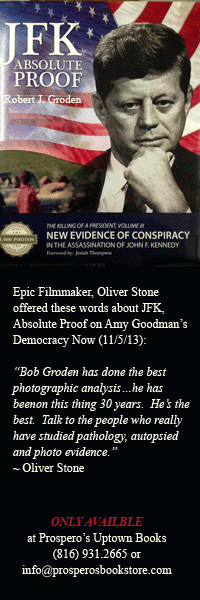 It’s not looking good for the anti-smoking zealots’ rushed-to-judgment ban on smoking in public places...
It’s not looking good for the anti-smoking zealots’ rushed-to-judgment ban on smoking in public places...
Oh, dear – tisk, tisk – not good at all.
Kansas City’s anti smoking ordinance governing bars, restaurants and other public places is highly likely to be struck down by Missouri’s court of appeals just in time for summer, says Jonathan Sternberg, an attorney representing a consortium of bars, restaurants and other businesses affected by the ban.
And for good reason…
“There’s a very old Missouri statute that says that a city can only pass ordinances that are in harmony with the state law on the same subject,” Sternberg says. “It’s been on the books since 1889 and it’s never been amended.”
Nor is it likely to be, Sternberg ventures. This is not one of those dusty, forgotten laws still on the books but no longer relevant in today’s society.
“Hardly,” Sternberg says. “Not in the slightest – the courts have applied it dozens and dozens of times over the years.”
Not long ago the law was used to overturn an ordinance governing Payday loan businesses in the St. Louis area, Sternberg says.
“It’s a basic principle of municipal law that pretty much every state has,” he says.
In a nutshell, Missouri’s indoor smoking law requires that bars, taverns, tobacco shops, bowling alleys, pool halls and restaurants with a capacity of under 50 people are exempt from smoking bans.
Unfortunately the authors of Kansas City’s ban were not clever or fortunate enough to have researched this prior to authoring the current ban.
“Since Kansas City, every city in Missouri that has considered a smoking ban has included these exemptions in them,” Sternberg states.
The odds of the appeals court merely blowing Sternberg off: zilch.
“The Missouri court of appeals is taking us very seriously,” he says. “Is there a chance that either party could lose? Sure. But I feel that we will prevail – it’s a very clear case, and the court has already – with just two briefs from our side only before them – scheduled oral arguments for May 21st. So clearly they are taking us quite seriously. So now the case will be decided in the weeks after May 21st.”
Word is when KC city attorney Galen Beaufort learned of the Missouri law he warned the council in advance that the current ban might not be sustainable.
“Not true,” Beaufort counters. “Who told you that?”
Asked to provide further comment on KC’s ban versus the Missouri statute Beaufort replied: “Requests for comments need to be made through Mary Charles, the City’s Communications Officer.”
Stay tuned…










methlab
Goin down, down to the bottom, sun’s comin’ up smoke ’em if you got ’em. John Prine
craig glazer
Way to go Bill Nigro, the smoking laws that were in effect before the ban, were just fine, nobody was upset but the evil do-gooders, all it has done is hurt bar and entertainment biz in KC…The Legends did it right, you can smoke in bars after 9pm and just pay a small fee for the right to do it…if you don’t like the smoke don’t go to the bar…
burman dinstow
Gee,what a surprise–the lawyer representing the effort to overturn the smoking ordinance believes he’s going o win his case…probably because he’s such an excellent lawyer. I bet if you talked to the lawyer for the other side, he or she would say that side will win the case. Of course, we don’t know for sure because Hearne doesn’t know the basic journalistic step of talking to the other side.
HARLEYRIDER1978
THE AIR ACCORDING TO OSHA
Though repetition has little to do with “the truth,” we’re repeatedly told that there’s “no safe level of exposure to secondhand smoke.”
OSHA begs to differ.
OSHA has established PELs (Permissible Exposure Levels) for all the measurable chemicals, including the 40 alleged carcinogens, in secondhand smoke. PELs are levels of exposure for an 8-hour workday from which, according to OSHA, no harm will result.
Of course the idea of “thousands of chemicals” can itself sound spooky. Perhaps it would help to note that coffee contains over 1000 chemicals, 19 of which are known to be rat carcinogens.
-“Rodent Carcinogens: Setting Priorities” Gold Et Al., Science, 258: 261-65 (1992)
There. Feel better?
As for secondhand smoke in the air, OSHA has stated outright that:
“Field studies of environmental tobacco smoke indicate that under normal conditions, the components in tobacco smoke are diluted below existing Permissible Exposure Levels (PELS.) as referenced in the Air Contaminant Standard (29 CFR 1910.1000)…It would be very rare to find a workplace with so much smoking that any individual PEL would be exceeded.”
-Letter From Greg Watchman, Acting Sec’y, OSHA, To Leroy J Pletten, PHD, July 8, 1997
Indeed it would.
Independent health researchers have done the chemistry and the math to prove how very very rare that would be.
As you’re about to see in a moment.
In 1999, comments were solicited by the government from an independent Public and Health Policy Research group, Littlewood & Fennel of Austin, Tx, on the subject of secondhand smoke.
Using EPA figures on the emissions per cigarette of everything measurable in secondhand smoke, they compared them to OSHA’s PELs.
The following excerpt and chart are directly from their report and their Washington testimony:
CALCULATING THE NON-EXISTENT RISKS OF ETS
“We have taken the substances for which measurements have actually been obtained–very few, of course, because it’s difficult to even find these chemicals in diffuse and diluted ETS.
“We posit a sealed, unventilated enclosure that is 20 feet square with a 9 foot ceiling clearance.
“Taking the figures for ETS yields per cigarette directly from the EPA, we calculated the number of cigarettes that would be required to reach the lowest published “danger” threshold for each of these substances. The results are actually quite amusing. In fact, it is difficult to imagine a situation where these threshold limits could be realized.
“Our chart (Table 1) illustrates each of these substances, but let me report some notable examples.
“For Benzo[a]pyrene, 222,000 cigarettes would be required to reach the lowest published “danger” threshold.
“For Acetone, 118,000 cigarettes would be required.
“Toluene would require 50,000 packs of simultaneously smoldering cigarettes.
“At the lower end of the scale– in the case of Acetaldehyde or Hydrazine, more than 14,000 smokers would need to light up simultaneously in our little room to reach the threshold at which they might begin to pose a danger.
“For Hydroquinone, “only” 1250 cigarettes are required. Perhaps we could post a notice limiting this 20-foot square room to 300 rather tightly-packed people smoking no more than 62 packs per hour?
“Of course the moment we introduce real world factors to the room — a door, an open window or two, or a healthy level of mechanical air exchange (remember, the room we’ve been talking about is sealed) achieving these levels becomes even more implausible.
“It becomes increasingly clear to us that ETS is a political, rather than scientific, scapegoat.”
Chart (Table 1)
-“Toxic Toxicology” Littlewood & Fennel
Coming at OSHA from quite a different angle is litigator (and how!) John Banzhaf, founder and president of Action on Smoking and Health (ASH).
Banzhaf is on record as wanting to remove healthy children from intact homes if one of their family smokes. He also favors national smoking bans both indoors and out throughout America, and has litigation kits for sale on how to get your landlord to evict your smoking neighbors.
Banzhaf originally wanted OSHA to ban smoking in all American workplaces.
It’s not even that OSHA wasn’t happy to play along; it’s just that–darn it — they couldn’t find the real-world science to make it credible.
So Banzhaf sued them. Suing federal agencies to get them to do what you want is, alas, a new trick in the political deck of cards. But OSHA, at least apparently, hung tough.
In response to Banzhaf’s law suit they said the best they could do would be to set some official standards for permissible levels of smoking in the workplace.
Scaring Banzhaf, and Glantz and the rest of them to death.
Permissible levels? No, no. That would mean that OSHA, officially, said that smoking was permitted. That in fact, there were levels (hard to exceed, as we hope we’ve already shown) that were generally safe.
This so frightened Banzhaf that he dropped the case. Here are excerpts from his press release:
“ASH has agreed to dismiss its lawsuit against OSHA…to avoid serious harm to the non-smokers rights movement from adverse action OSHA had threatened to take if forced by the suit to do it….developing some hypothetical [ASH’s characterization] measurement of smoke pollution that might be a better remedy than prohibiting smoking….[T]his could seriously hurt efforts to pass non-smokers’ rights legislation at the state and local level…
Another major threat was that, if the agency were forced by ASH’s suit to promulgate a rule regulating workplace smoking, [it] would be likely to pass a weak one…. This weak rule in turn could preempt future and possibly even existing non-smokers rights laws– a risk no one was willing to take.
As a result of ASH’s dismissal of the suit, OSHA will now withdraw its rule-making proceedings but will do so without using any of the damaging [to Anti activists] language they had threatened to include.”
-ASH Nixes OSHA Suit To Prevent Harm To Movement
Looking on the bright side, Banzhaf concludes:
“We might now be even more successful in persuading states and localities to ban smoking on their own, once they no longer have OSHA rule-making to hide behind.”
Once again, the Anti-Smoking Movement reveals that it’s true motive is basically Prohibition (stopping smokers from smoking; making them “social outcasts”) –not “safe air.”
And the attitude seems to be, as Stanton Glantz says, if the science doesn’t “help” you, don’t do the science.
Glass Safety Stickers
Glass Safety Stickers…
For birds to avoid flying into glass, they need to see it and recognize it as a solid object. To that end, homeowners have to sacrifice their view somewhat by attaching decals, stickers, or other readily visible matter to the outside…
znakomstva
?????????????, ? ????????????! ??????? ? ?????????!
????????
???????) ???? ??? ?? ??????????))
conrad davis
Hello just thought i would let you know i had a problem with this blog appearing blank also. Must be chimpanzees in the page.
800 Vanity
I visit your site every once in a while and I must mention that I like your template!
Carroll Toll Free Numbers
Howdy I sumbled upon your post by sheer luck, I was browsing Google for toll free 1888numbers when I came upon your webpage, I must say your blog is really interesting I truely think the layout, its amazing!. I don’t have the time at the moment to totally browse your blog but I have saved the location of it and also signed up for your RSS feeds. I will be back when I free up some time. Bravo for a great site.
Sherrell Sensenbrenner
Oh my God, you mad freak! That’s amazing post.
Aaron Francis
I was writing a paper fr one of my college classes about the ban and ran into this article. First I was like what? is this legit. But after doin more research it was nice to see the ban was only tempoarily not in effect 🙂